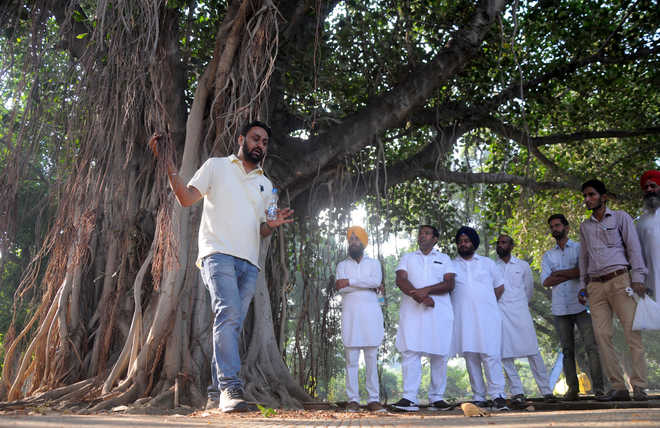
Tree Walk: Dr Balwinder Lakhewali shows bohar to people at Punjab Agricultural University in Ludhiana. Tribune Photo: Himanshu Mahajan
Minna Zutshi in Ludhiana
Avast expanse of green canopy is common in rural areas, but what’s uncommon is to find a method and mission in it. Lakhewali village in Sri Muktsar Sahib is one such village in Punjab which has given a new meaning to tree plantation. Through a unique approach, it has presented a great model to save native trees which are fast becoming extinct.
Chandni trees dot either side of village approach roads. Every house has a fruit tree, either guava or lemon. Amla, soanjana, curry and neem trees along with one among from guava, lemon and grape surround all tubewells. Bushes of fragrant flowers neutralise any odour emanating from the village’s solid waste management. Community centres and religious places stand distinct with the selection of trees and speak volumes about the efforts that have gone into revival of native trees.
Thanks to environmentalist Dr Balwinder Singh Lakhewali and floriculturist Dr Brij Mohan Bhardwaj, Lakhewali village has become a successful model for revival of native trees. The zeal shown by the Lakhewali panchahyat and youths has rubbed on to other villages to replicate the success. At Khosa Randhir village in Moga district, a special space has been earmarked for tree species native to the region.
Unfortunately, once a familiar sight in Punjab, many tree species are on the verge of extinction. For instance, ‘lasora’ (Cordia dicotoma) tree, which has amazing use from kitchen to pharmacy to agriculture, is not as easily visible as it used to be. Not so long ago, this hardy tree was a part of the landscape of Punjab. Trees like Sita Ashoka (Saraca asoca) and harshingar (nyctanthes arbor-tristis), associated with Lord Krishna, are also not being planted around.
“Intensive agricultural activity, abysmal lack of knowledge and an apathetic attitude are responsible to a large extent for the situation,” says Dr Lakhewali, project director, ATMA (Agricultural Technology Management Agency).
Several tree species that are facing a steep decline in their numbers include peelu (Salvadora oleoides), jand (Prosopis cineraria), kareer (Caparis decidua), roheda (Tecomella undulata, phulahi (Acacia modesta), malha ber (Ziziphus nummularia) and hinjan (Balanites roxburghii). Surprisingly, despite their numerous health benefits, many species are fighting for survival.
“Health-oriented groups on social media cannot stop raving about the medicinal value of soanjana (Moringa oleifera). It may be a surprise for them that the tree was earlier found extensively in Punjab. Its seeds yield edible oil that is utilised in cosmetic industry,” says Dr Bhardwaj.
Interestingly, at a time when there’s special emphasis on planting more trees and conserving environment, there is a threat to several species. Dr Bhardwaj and Dr Lakhewali blame it on plantation drives that have become target-oriented and more of a political exercise.
In the number game, the technicalities about the plantation, the selection of tree species and the follow-up after the plantation are not only overlooked but wilfully ignored. The trees that once were a part of our cultural heritage hardly find any space in this self-laudatory spectacle, they stress.
In utter disregard to the basics of selecting the best-suited species, tall trees are planted on roadsides. No wonder, you find these trees threatening to touch the overhead electricity wires!
It is strange that a long-lived tree species like Jivapota (Putranjiva roxburghii) that is good for urban areas remain underutilized, says Dr Bhardwaj.
Spacing too is of utmost importance. “Often the people get carried away by the idea of planting ‘triveni’ i.e. neem, peepul and banyan. These three species are planted so close together that often the neem tree is strangulated by the peepul and banyan trees. Finally, only the banyan tree remains intact!” he adds.



























